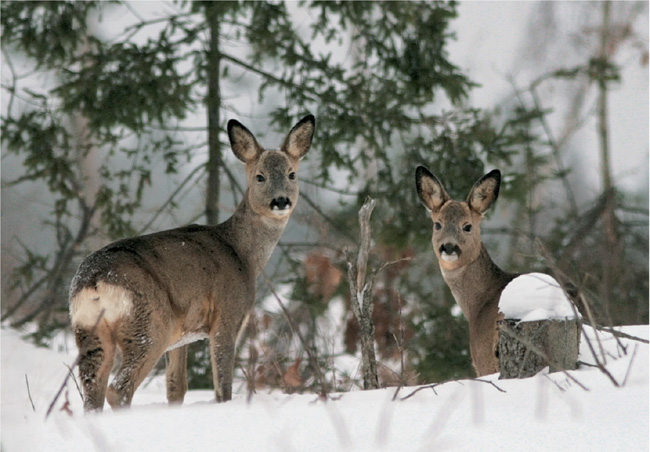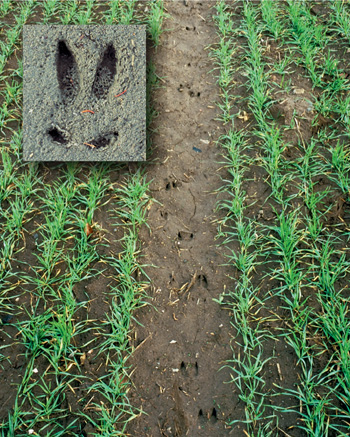
Capreolus capreolus
Roe Deer is one of the smallest deer in Europe, 95–135 cm long, with a 2–4 cm tail, mostly obscured by the coat. It is 65–75 cm at the shoulder, and males are larger than females. In much of Europe, Roe Deer weigh 20–25 kg; in northern Scandinavia, they can weigh up to 35 kg.
The summer coat is reddish brown on the sides and back, the belly somewhat lighter. The winter coat is greyish brown and significantly thicker; the coat of some Roe Deer can be dark brown, almost black. The buck has small antlers, two branches with three pointed ends each, once the animal is two years old. The antlers grow in the spring and are shed in November/December.
Roe Deer live in open woodland with thick underbrush and in clearings, with open farm fields or uncultivated areas nearby. They are active at dusk and dawn, but in summer, if undisturbed, can be active all day.

The tracks are 4–5 cm long and 3 cm wide, those of younger individuals more pointed; the tracks of older deer are rounded. There are no differences between the prints of bucks and does. The footprints are almost parallel, with the splaying more pronounced at increased running speeds; the prints of the front feet are V-shaped. If the animals run very fast, you can also see the imprints of the dew claws, and the same is true when the animal moves over soft terrain. The stride is 60–90 cm.
Roe Deer have white around the tail. IK.

Roe Deer dig under the snow for plants. Inset: A track in snow with the prints of dew claws. PB.

When moving at a leisurely gait, a Roe Deer places its hind feet in the prints of the front; when running, it often places the hind feet ahead of the front. In flight, or when galloping, the hind feet are set outside and significantly ahead of the front footprints.
An adult buck with velvet on its antlers. ME.

The tracks of Wild Boar are wider and heavier, and those of Fallow Deer, longer and narrower.
Roe Deer often use the same trails between hiding places in the woods and from one field to another; frequently other animals use these paths as well, and as a result, the trails become well trodden. In snow these trails are easily seen, and you can also find depressions in the snow where deer hide during the day.
Adult bucks lay claim to a territory from May to September, marking it with both scat and secretions from glands on their forehead and between their hooves. To mark territory, the buck rubs its forehead against small trees and bushes and simultaneously scratches the ground with its front feet. Bark and small branches are ripped off small trees, and you can also find long rub marks made by antlers. You see the same rub marks from the end of March to the middle of April, when the buck uses small trees and bushes to remove the velvet from its antlers. The trees involved are normally no more than 2 cm in diameter. The buck sheds its antlers between October and December.
Roe Deer tracks in a field and in sand. LG; inset, LJ.

Roe Deer does give birth in May. The fawns are spotted for the first few months of their lives. MDDH.

Roe Deer bucks rub their antlers on young trees and large bushes. LG.

A Roe Deer’s territorial markings. AK.

In summer Roe Deer feed on plants, but they are quite picky. They strongly favour certain plants, for instance, anemones. These animals also like polyantha roses and fallen fruit, especially apples, and may also consume mushrooms.
In winter Roe Deer eat all the green plants they can find and also graze on heather and blueberries as well as buds and branches of trees and bushes, especially hazel, oaks, poplars, and spruce. Roe Deer do not normally gnaw on bark the way larger deer species do, but in the case of a young spruce, they might feed on the tallest shoots and many of the lower branches. The gnawing of a Roe Deer, unlike that of a hare, leaves clear fray marks (cf. p. 62). A young tree with lower branches grazed will develop new ones and become very dense in the regenerated areas. You can see also this phenomenon in young oaks.
Roe Deer scat is cylindrical, 10–16 mm long and 7–10 mm thick, black or dark brown, slightly pointed at one end, and rounded at the other. In summer, Roe Deer can leave scat in large, more or less cohesive clumps, but normally scat will be scattered. The deer also defecates while walking, so you can find individual clumps between footprints.
When ruminating or resting, Roe Deer normally lie on the ground. Unlike other deer species, Roe clear away any leaves or branches and occasionally even the vegetation itself before lying down. The resting area is about 60 cm long and 40 cm wide, and you will find plentiful scat nearby.
Roe Deer scat in summer. LG.

Roe Deer scat in October. LG.


In summer, bucks usually move to an area that may also be home to several does. The does stay with their offspring from the previous year up to the next mating season, the end of July to August, then chase the young away. When a buck meets a doe ready to mate, it will often follow her closely during the one-day rutting period. Shortly before mating, the doe runs around in a tight circle, closely pursued by the buck. As a result, circular trails are formed in the plant cover, and these are called ‘fairy rings’.
Young Roe Deer. JKK.
